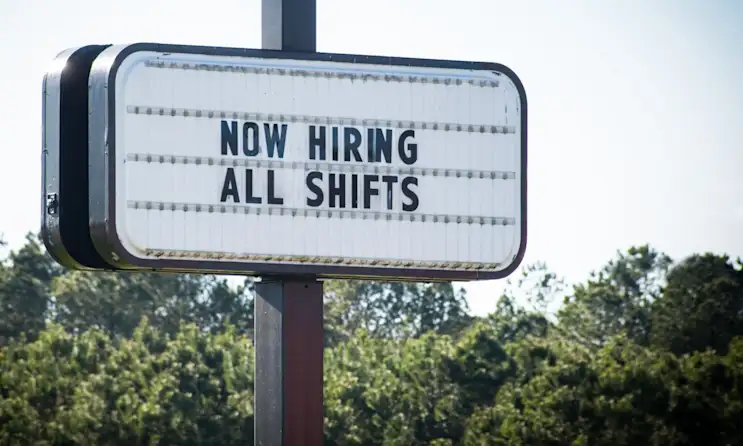Staffing
To Win the War for Talent, Restaurants Must Evolve as Employers
September 16, 2021
Worker priorities are changing. The restaurant workplace needs to change with them.
When federal unemployment benefits expired last week, many in the restaurant community hoped it would end the unprecedented worker shortage that has crippled the industry’s recovery from COVID-19.
In January 2021, just 8% of restaurant operators called recruiting and retaining employees their top business challenge, according to the National Restaurant Association. By June, that number had ballooned to 75% — the highest level ever recorded:
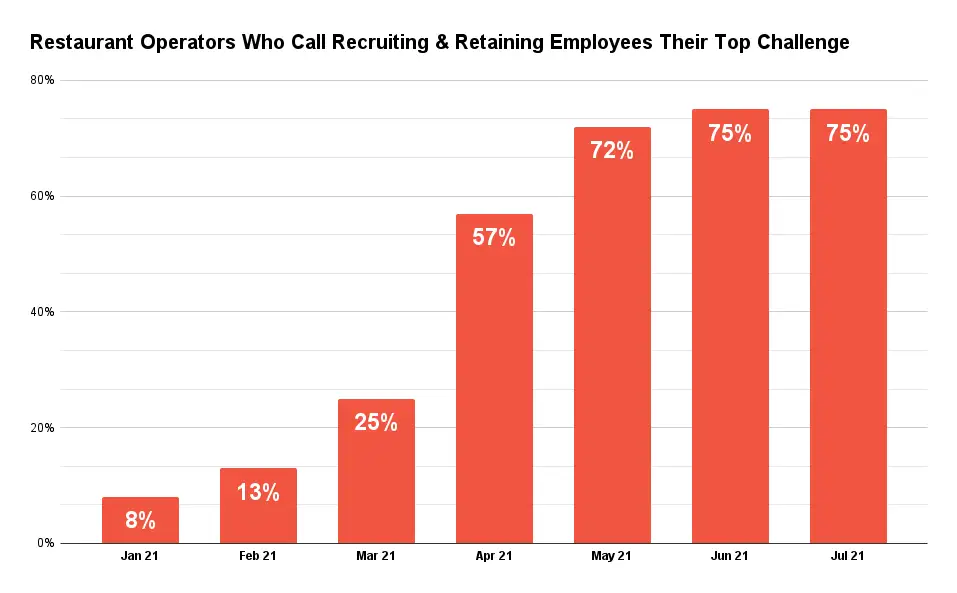
Workers have stayed home, in part, because enhanced unemployment benefits have made doing so financially possible. However, that doesn’t tell the whole story. According to labor economist Laura Dresser, research on states that ended the supplement early showed it had “very little impact on the overall labor supply.”
How could that be? According to Alice Cheng, founder & CEO of hospitality career website Culinary Agents, the pandemic gave workers a chance to step back and reevaluate their priorities. In doing so, they reconsidered whether working in a restaurant was right for them. “Some of those folks have found careers and happiness doing other things,” Cheng told BentoBox. “They weren’t going to turn on a dime to go back to the way things were.”
Anthony Anton, CEO of the Washington Hospitality Association, shared similar thoughts with the Seattle Times. He said he’s warned his members not to count on cooks and servers returning when the benefits end — and notes that even if every single hospitality worker currently claiming unemployment did return, the industry would still be short 50,000 workers, many of whom have left for other industries.
All of this puts restaurants in a challenging long-term hiring position. Operators need to attract more employees, but they also work in an industry with notoriously low margins, making it difficult to compete with offers from outside employers. They can’t wave a magic wand to make more money appear, nor can they wave one to make workers forget the past few months and willingly return to the status quo.
However, with a mix of modern revenue-driving strategies and thoughtful workplace improvements, they can find a middle ground that brings workers back — and keeps them happy — while staying profitable. Here are four essential approaches for recruiting and retaining restaurant staff moving forward.

RESOURCE
Restaurant Job Description Templates
Hire faster with 33 templates for front-of-house, back-of-house and specialized restaurant job postings.
1. Continue to Offer Competitive Pay and Benefits
Zoë Ezrailson, a back-of-house veteran from Washington, DC, didn’t mince words when she spoke with Laura Hayes of the Washington City Paper. “This is a career job,” she said emphatically. “I want all of the things that people in careers have. …Health insurance should not be a question if you’re in the kitchen working with fire and knives.”
To a restaurant industry outsider, that might sound obvious. But before the pandemic, very few restaurant workers had critical benefits such as health insurance, much less 401(k) and childcare assistance. In a 2019 survey of restaurant owners, Toast found that fewer than one-third offered health insurance and even fewer offered other benefits:
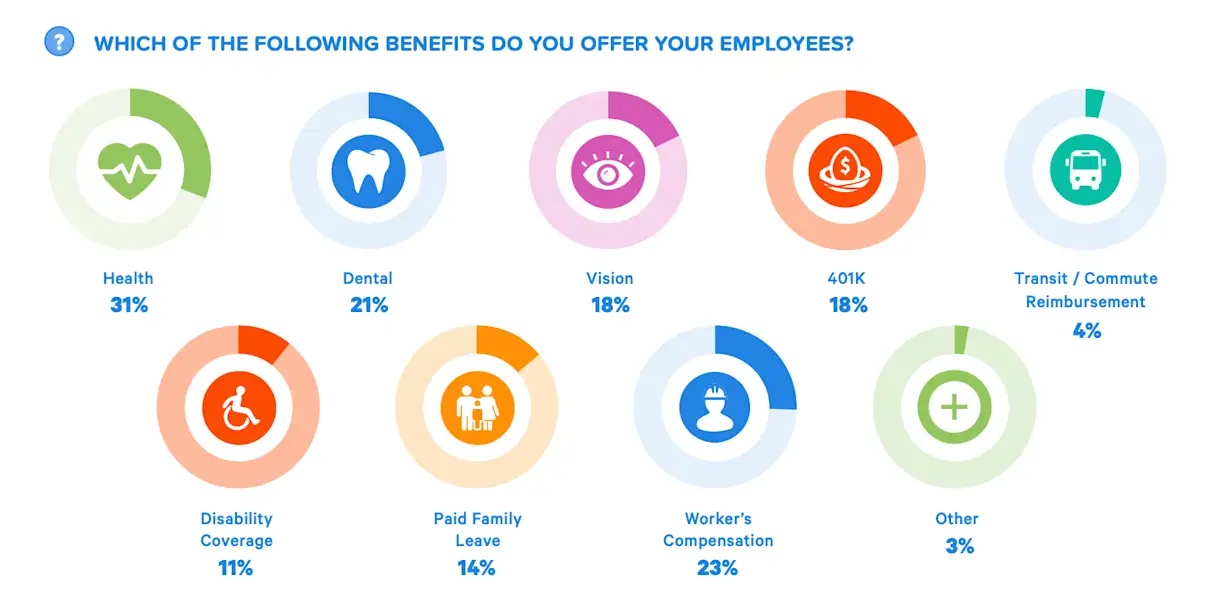
When the staffing crisis hit in 2021, restaurant owners began to offer packages that felt more like the “career job” Ezrailson described, including not just benefits but competitive pay. According to the Bureau of Labor Statistics, wages for leisure and hospitality employees rose 5.7% between March and May 2021 — five times higher than the rise for private employees.
Business owners did this because they felt like they had to, given enhanced unemployment benefits, but they won't just be able to put the genie back in the bottle. Workers like Ezrailson have gotten a taste of jobs with better wages and benefits, and they don’t plan on giving them up.
“For businesses that said, ‘Well, this is what we did before, let's just do it again,’ we saw them reevaluate that approach pretty quickly,” said Cheng. “They either realized they weren't getting the applicant flow, or they were getting direct feedback from applicants asking, ‘Do you offer anything else?’”
Before the pandemic, few restaurant workers would have dared to ask that question. In the new normal, restaurant management needs to be prepared for it — and have a good answer. The pandemic gave workers a chance to reevaluate their priorities, and for many it exposed them to other, more comfortable career options. It also exposed consumers to the conditions many restaurant staff, who were hailed as “frontline workers,” endure.
“The pandemic put some of the industry's faults on display to the rest of the world,” said Cheng. “The lack of benefits, pay inequities between front and back of house and overall working conditions are just a few areas diners were unaware of.”
Despite the pandemic many restaurant workers are still cooking to-go orders in the kitchens of your favorite restaurants where physical distancing is almost impossible. Most are using no PPE. Majority have no health insurance.
— Donna Imam (@donnaimamTX) April 7, 2020
Between worker awareness, worker leverage and public pressure, it’s hard to imagine a future where restaurants revert to the old model of no benefits and low wages. Those that try will likely find hiring in the new normal as difficult as it has been this summer. Why would workers accept that when other restaurants in the area, plus outside employers, offer wages and benefits they know firsthand are life-changing?
It used to be that restaurant owners could not afford to offer higher wages and benefits. Moving forward, they can’t afford not to. But where are they going to find the extra money?
2. Explore All New Revenue Streams
Operating a restaurant requires wearing many hats, and each one brings a new set of responsibilities:
As an employer, you owe it to your workers to offer competitive pay and benefits.
As a business, you owe it to your customers to offer a product they like at a price they deem fair.
As an individual, you owe it to yourself and your family to earn a profit and support your life.
Unfortunately, it’s extremely difficult to check all three boxes at once. Doing wrong in the eyes of customers jeopardizes your business, and failing to offer competitive pay and benefits seems likely to do the same moving forward (see above). If they still want to earn enough money to support themselves, restaurant owners have only one option: drive more revenue.
This sounds like obvious advice, but before the pandemic, many restaurant owners ignored emerging revenue streams like direct online ordering, loyalty programs and merchandise stores. The pandemic forced them to learn new tricks, and the labor movement will force them to continue testing, learning and adapting.
"I imagine a lot of restaurant owners will probably reflect on what they were forced to do in the past year,'' explained Cheng. “Certain businesses who vowed to never do delivery because it's not the same experience and the food doesn't travel a certain way — all of a sudden, it's the lifeline keeping them afloat. Now, as businesses look at recovery, many of them are folding in new revenue streams and reshuffling their business models to make way for growth.”
Restaurants have already begun raising menu prices to offset rising operating costs, but they can only go so far without jeopardizing sales. In addition to pocketing marginally more money from their core revenue stream, they need to find and maximize additional revenue streams. It’s the best (and in some cases, only) way to make the math work.
For example, Nick’s Cafe is a 73-year-old diner in Los Angeles — as old-school as old-school gets. Before the pandemic, its website was extremely limited, and a meager share of its business came from takeout. When the pandemic struck, owner Rod Davis pivoted quickly, creating a custom website with direct online ordering that helped him survive the lockdowns:
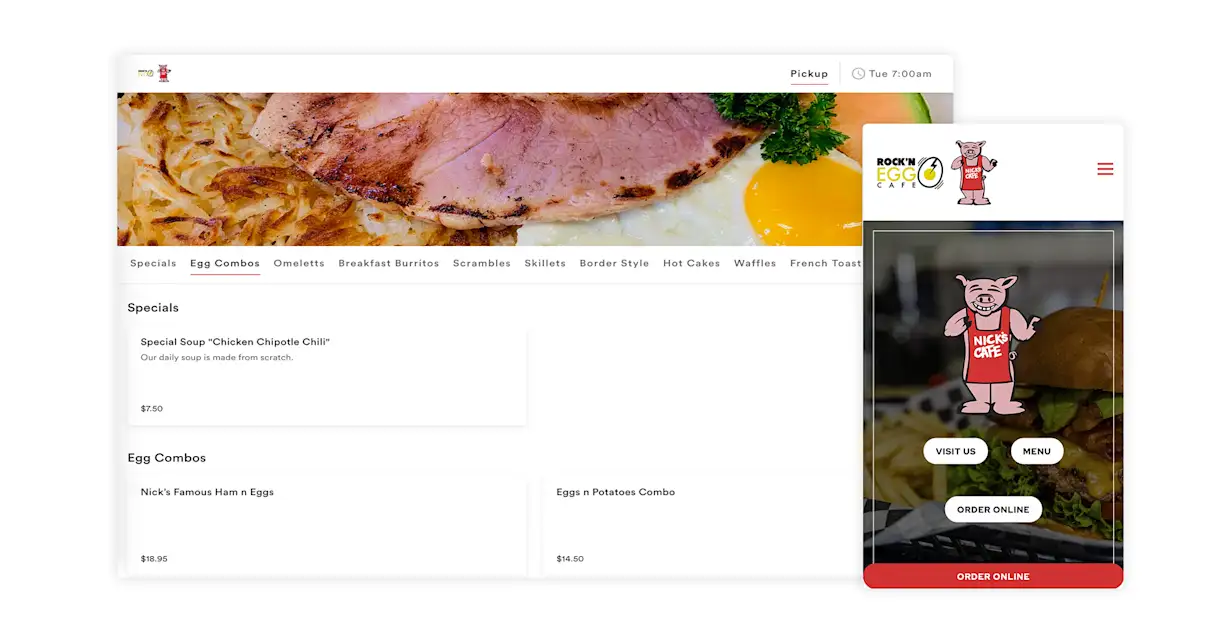
“Now we try to steer everybody to the new website for ordering because it’s cheaper for the customer, and it’s better for us,” Davis told Zagat. “...In every to-go order, we include a little flier encouraging customers to go to our website. Any menu or anything we hand out has the QR code that sends them to the website.”
Restaurant commerce has been changing for years, particularly with regard to technology. Before the pandemic, embracing those trends was an opportunity — but now it’s a necessity. Restaurant owners owe it to their workers to be nimble, experimental and open to change, even if it makes them uncomfortable.
If they aren’t, workers will find an employer who is. Because it probably means that employer can offer more money and better benefits.

RESOURCE
Restaurant Employee Handbook Template
Improve staff retention and centralize key information with an employee handbook for your restaurant. Grab this free template!
3. Build a Strong Employer Brand
Restaurant jobs are demanding, and to a certain extent they always will be. But far too many restaurants have used the inherent demands of the industry to justify running unhealthy workplaces. The pandemic gave workers the perspective to realize they need their employers to do better, along with the leverage to insist upon it.
“People felt abused in the beginning stages of opening back up,” said Reesey McElvane, a bartender from Washington, DC, who told Hayes she knows people who recently left the industry after 20+ years. “It shook people enough to say, ‘I don’t think I want to get back into this.’ If you’re not going to follow protocols and you’re not going to have my back if guests get out of line, what’s the point?”
“I’m being choosy,” added Paul Hofford, an out-of-work bar manager who told Hayes that he misses clocking in. “I’ve only sent in two or three applications. If I’m going to be working, it has to be a place I want to be.”
As workers become more selective regarding where they work, Cheng encourages restaurants to prioritize their employer brands, or how they position their workplace culture to prospects. Doing this requires some effort, but it’s worth it because, as Cheng explains, “your employer brand is constantly selling and supporting your [recruitment] efforts.”
To help restaurants get started, Culinary Agents conducted a February 2021 survey to learn what applicants valued during the job search process:
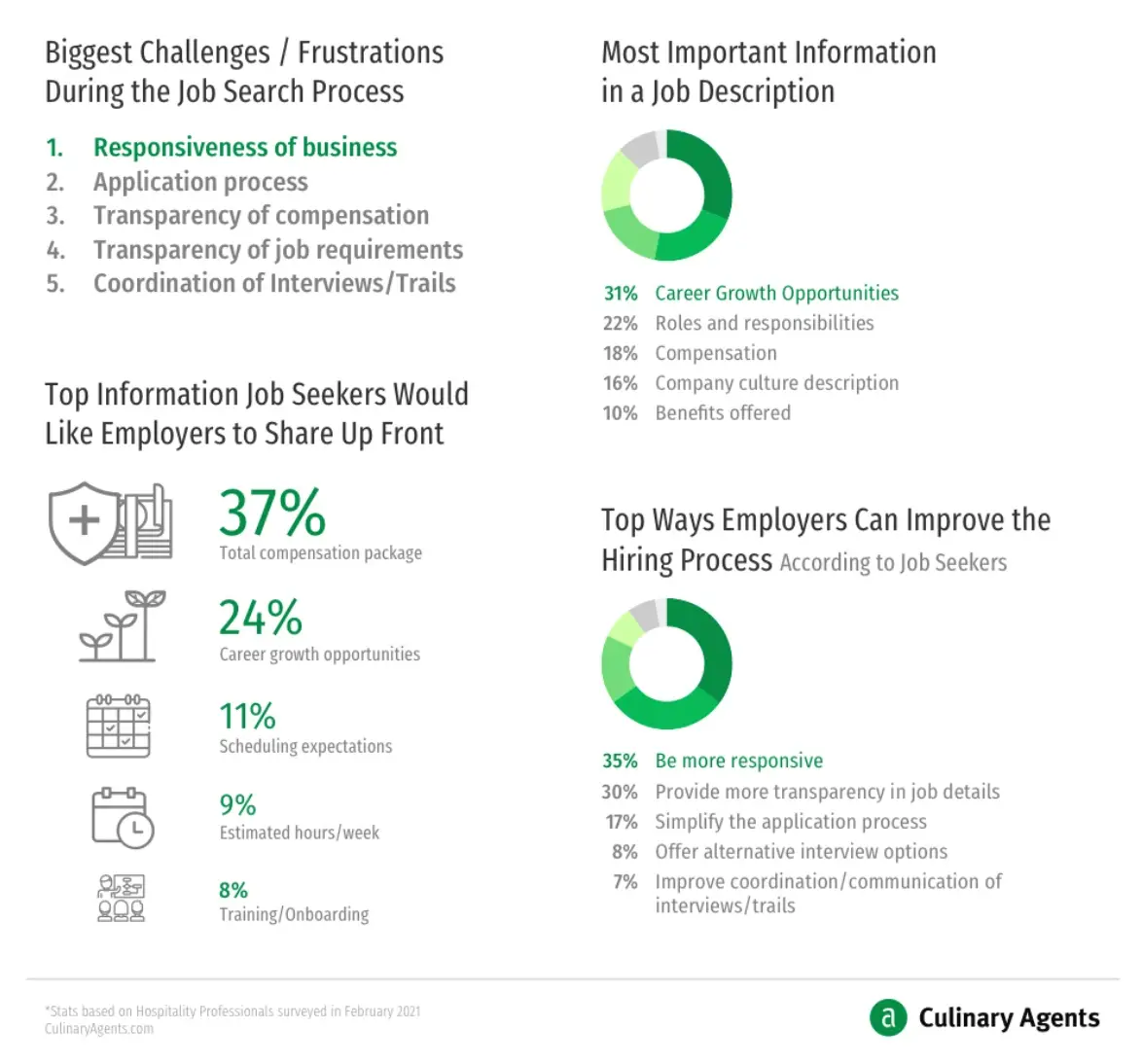
Restaurants can use insights like this to identify gaps in their current approach or highlight existing strengths. It’s easy for restaurant management to fall behind on correspondence with applicants, given their hectic schedules — but making the extra effort signals that the restaurant has an organized, empathetic culture. That the management team values workers’ time, even when things are busy.
Similarly, if your restaurant has a history of hiring from within, focusing on your employer brand means going above and beyond to communicate that. Career trajectory should be spelled out in your job descriptions, and stories of prominent staff who rose the ranks should be plastered on your website and social media channels.
Just make sure the culture you’re selling is true to the culture you have. Embellishing your culture to applicants might help you hire employees in the short-term, but it won’t help you retain those employees, and it won’t help you hire the people those employees speak with. In the words of Katie Barongan, vice president of HR and recruiting for Clyde’s Restaurant Group: “Be true to who you are. Candidates see that. As long as you’re doing what you say, hopefully you’ll find long-term employees.”
4. Streamline Operations With Technology
Properly applying technology to make your restaurant operations more efficient has two major benefits for workers:
Automating tasks reduces how much staff you need on each shift, allowing more budget to go toward individual salaries and benefits.
Eliminating tedious, inefficient and frustrating work allows staff to be more intentional with their time, improving your workplace culture and employer brand.
The point about automation is sometimes met with pushback. However, in the midst of a labor shortage, restaurant owners can hardly be blamed for offloading tasks to technology — especially if it creates a better workplace for the limited staff they have.Jamie Merisotis, author of the book Human Work in the Age of Smart Machines, adds that it’s misguided to focus too much on job loss as a result of automation, given that technology has always created more jobs than it destroys.
“Employers and workers need to examine the tasks their jobs consist of and think about which ones could be automated,” Merisotis told Staffing.com. “But they also need to think about the tasks that machines can’t do — those that rely on uniquely human traits and abilities. I call this human work, and it is the work of the future.”
For example, Dave & Buster’s rolled out a new service model during the labor shortage. Using tablets and a mobile web platform that allows for contactless dining, it expanded the size of server sections and earned positive feedback from staff and guests alike. When the company posted record-breaking revenue growth in Q2 2021, it cited the new technology as a key factor.
"From full deployment to-date, over 50% of our [guests] are utilizing this mobile channel,” COO Margo Manning told analysts. “This technology will help transform our business model and it allows us to operate more efficiently.”
Before the pandemic, more than 80% of restaurant owners said using technology provided a competitive advantage. After the pandemic, simply using technology won’t be enough: The advantage lies in using technology thoughtfully. For hiring and retention, this means ensuring the tools you license are designed to solve operational problems and working with staff and tech providers to optimize your process over time. If you go the extra mile to make each shift a little better for your employees, your employees will go the extra mile to work for you.
Final Thoughts
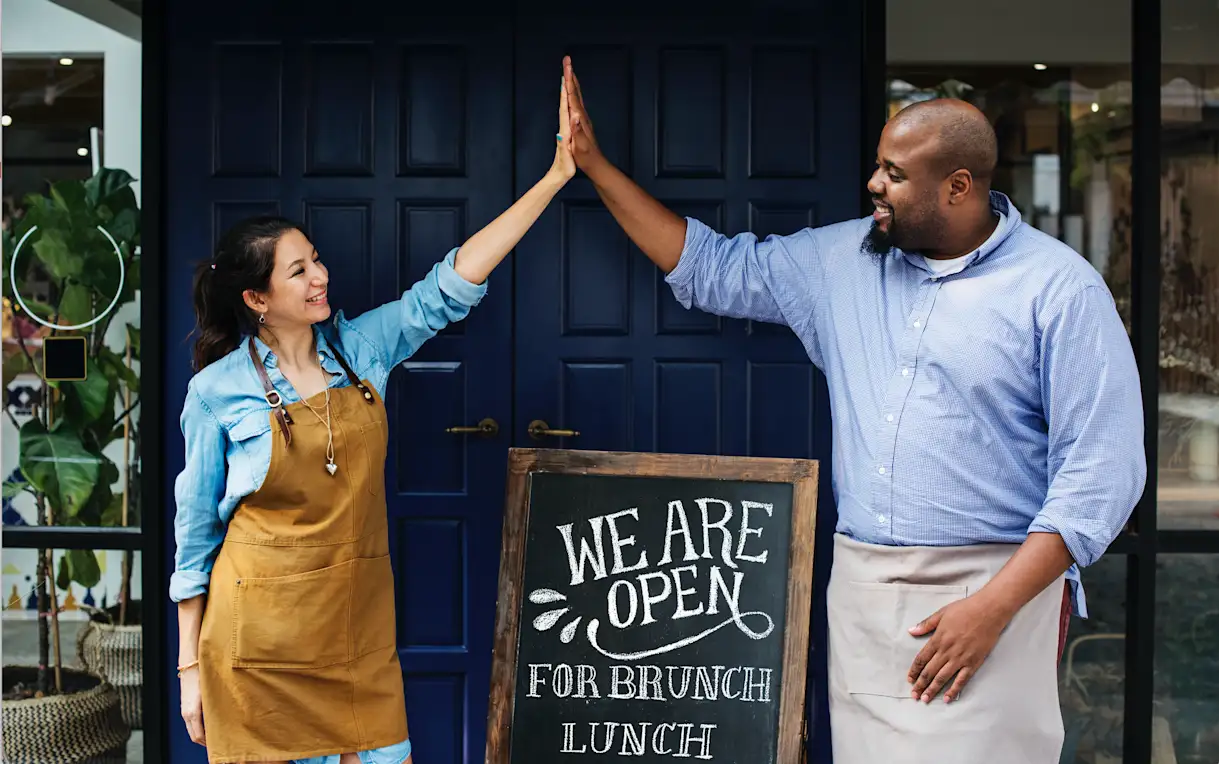
As they attempt to make their workplaces more attractive, restaurant owners have one more important tool in their arsenal: other restaurant owners. “Competition is coming from every direction,” explained Cheng. “It's not just the restaurant down the road; other industries and alternative career paths are folded into the mix now more than before.”
The restaurant industry has always been one where business owners prop each other up despite competing for share of wallet. This unique trait proved important during the pandemic, and it will continue to prove important during recovery. If restaurant owners share tips, advice and feedback regarding the strategies above, it will help the entire industry evolve faster. That is what needs to happen for restaurants to win the war for talent. Not one restaurant becoming “the good place to work” in town.
After all, a rising tide lifts all boats.

BentoBox Marketing & Commerce Platform
Deliver Smarter Hospitality
Want to stand out online, bring in more money, engage your diners, and streamline operations?
Recommended

Interview
Q&A with Jordan Boesch, Founder & CEO of 7shifts on Staffing for the Holidays
November 20, 2020
On some of the challenges that restaurants face and advice on optimizing staffing for the holiday season.
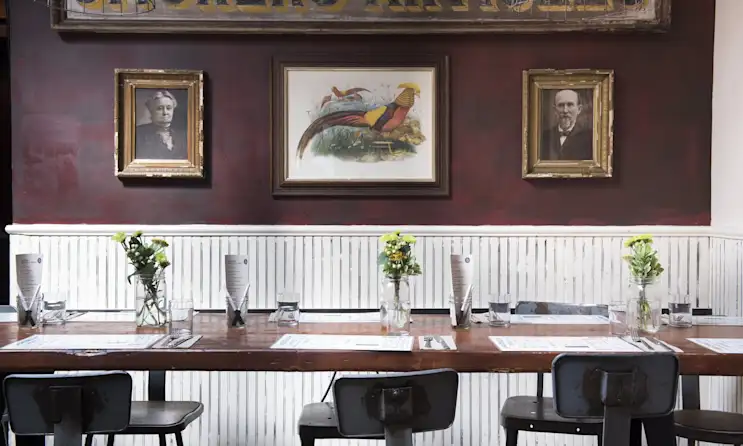
Interview
How to Keep Team Spirits Bright
December 14, 2016
The Meatball Shop’s tips for maintaining strong team spirits during the busy holiday season


